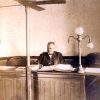calsfoundation@cals.org
Henry Woods (1918–2002)
Henry Woods started his legal career in New York City during World II as an agent with the Federal Bureau of Investigation (FBI) monitoring the pacifist activities of the legendary pilot Charles Lindbergh and investigating the crash of a B-25 bomber into the Empire State Building on July 28, 1945. He returned to Arkansas after the war and began a legal and political career that immersed him in the state’s historic struggle over civil rights and the schools—the last twenty-three years as a federal judge presiding over the state’s longest-running school-desegregation lawsuit and another case that entangled him in the Whitewater investigation of President Bill Clinton, his wife Hillary Clinton, and numerous other Arkansans.
Joseph Henry Woods was born on March 17, 1918—St. Patrick’s Day, he liked to point out—to the farming family of Joseph Neal Woods and Mary Jett Woods at Abbeville, Mississippi, a small town near Oxford. The family, which included Henry’s older sister, moved to Hot Springs (Garland County), where Woods graduated as valedictorian from Hot Springs High School in 1934, four years behind Sid McMath.
Like McMath, Woods attended the University of Arkansas (UA) in Fayetteville (Washington County). He obtained a bachelor’s degree, concentrating on literature, in 1938, and graduated cum laude from the University of Arkansas School of Law in 1940. He took FBI training, became a special agent in New York City, and married Kathleen Mary McCaffrey of nearby Jersey City, New Jersey, on New Year’s Day, 1943, in St. Patrick’s Cathedral in Manhattan. They lived in Newark, New Jersey, and had four children. Their son James M. Woods became a historian who wrote a book about the history of the Catholic Church in Arkansas.
After the war, the family moved to Texarkana (Miller County), where Woods opened a trial practice. He succeeded McMath as president of the Young Democrats of Arkansas. McMath asked the younger Woods to join him in a race for governor in 1948 and run his campaign. The two new trial lawyers began a collaboration that lasted until Woods’s death in 2002. The two pushed for the state Democratic Party to accept African American participation and resist the new States’ Rights Democratic Party (a.k.a. Dixiecrats), who were pushing Strom Thurmond of South Carolina as their presidential candidate against Harry Truman. Arkansas broke with other Deep South states and voted decisively to reelect Truman. Thurmond was a distant third in Arkansas.
After managing McMath’s campaign, Woods became his executive secretary for four years and ran the highway-building program that was McMath’s big promise and his major achievement, but one with a nasty political downside. McMath delegated the highway program to Woods, who, along with a young protégé, Orval E. Faubus of Huntsville (Madison County), met with delegations from all over the state seeking aid for highway improvements. McMath would later appoint Faubus to the Arkansas Highway Commission. McMath and Woods wrote a constitutional amendment—later called the Mack-Blackwell Amendment—that assigned a state highway commissioner from each congressional district with staggered ten-year terms, which seemed to ensure the agency’s independence from politics for the first time. The Arkansas General Assembly adopted it in 1951, and the voters ratified it in 1952. However, an independent highway audit in 1952 concluded that there was evidence that groups often had to contribute to McMath’s campaign fund, controlled by Woods, to get their projects funded by the Arkansas Highway Department or to get contracts. McMath and Woods always denied that it happened, but the audit tarred McMath and Woods and undoubtedly contributed to McMath’s defeat by Francis Cherry in 1952 and again when McMath challenged Senator John L. McClellan in the senator’s reelection race in 1954.
McMath and Woods opened a law firm with Leland Leatherman in Little Rock (Pulaski County) in 1953, and it eventually became the leading trial firm in the state, representing unions and injured workers. The spellbinding McMath and brainy Woods, who became an authority on tort law, made an indomitable pair in front of jurors and judges. After the pair won a record judgment for a riverboat worker who lost his limbs in an accident on the Arkansas River near Pine Bluff (Jefferson County), the St. Louis attorney for the riverboat company noted that the federal judge, former congressman Oren Harris, would turn to Woods when there was a discussion of some legal precedent and ask him what the law said. Woods wrote a textbook (Comparative Fault) on tort law, which is still in use in many law schools.
Woods was one of the few white men in the 1950s to advocate civil rights for African Americans. In 1956, he and McMath drafted an amendment to the state constitution, called the Free Vote Amendment, ending the annual poll tax as a requirement for voting, although it would be 1964 when the state finally ended the tax.
In September 1957, the Little Rock schools were under federal court orders to desegregate. As the day neared, Faubus consulted with old supporters like McMath, Woods, Winthrop Rockefeller, and Edwin E. Dunaway about what to do since he was under immense political pressure to do something to prevent integration, which the state’s new constitutional amendment—the so-called interposition amendment ratified in 1956—seemed to compel the governor to do. He decided to mobilize the Arkansas National Guard to block the nine Black students known as the Little Rock Nine from entering Central High School. McMath later wrote in his memoir, Promises Kept (2003), that he, Dunaway, and others met at Woods’s home several times to discuss how to defuse the crisis. When Faubus invoked a new statute allowing him to close the city’s high schools faced with integration in the fall of 1958 (what is known as the Lost Year), Woods organized the political campaign in 1959 to defeat segregationist members of the Little Rock School Board and reelect moderates determined to reopen the high schools.
Woods’s appointment to a federal district judgeship by President Jimmy Carter in 1980—at the age of sixty-two, when most judges are approaching retirement—again put him at the center of the never-ending litigation over the segregation of public schools in Pulaski County. A fresh lawsuit over segregation in the three big school districts landed in his court in 1982. Woods moved every case along quickly, admonishing lawyers to quit delaying and get to a trial and verdict. The lawsuit alleged that the Pulaski County and North Little Rock (Pulaski County) schools did not comply with federal court rules on integration and that the Arkansas Department of Education had been historically responsible for the burden of racial discrimination on Little Rock schools.
Woods handed down a sweeping 17,000-word decision in April 1984. It said the Little Rock district, despite good-faith efforts to comply with court orders to form a unitary school system, was likely to become a segregated all-Black district if trends continued, that the other two districts were in flagrant violation of the established law, and that the Arkansas Department of Education had contributed to the burden on Little Rock schools. He ordered consolidation of the three districts and eventually state aid to the Little Rock schools to compensate for the burden the state had placed on the Pulaski County schools. Eventually, the legislature appropriated almost $130 million to the three districts for remedies such as magnet schools and busing. But the Eighth U.S. Circuit Court of Appeals eventually overruled the consolidation order and ordered an expansion of the Little Rock School District to city boundaries. After repeated frustrations with the appellate court’s revision, Woods said a final remedy was hopeless and in July 1990 recused himself from the case.
That suit was followed by a suit filed by five Black and two white Arkansas legislators asking Woods to declare unconstitutional Amendment 44, the interposition amendment written by future Arkansas Supreme Court justice James Douglas “Justice Jim” Johnson. Woods did so in Dietz v. State in March 1989. “Since the defendants concede that this amendment violates the Supremacy Clause of the United States Constitution,” Woods wrote, there was no reason to prolong the case.
In September 1995, Woods made national news with an order dismissing federal charges brought by Whitewater independent prosecutor Kenneth Starr against Governor Jim Guy Tucker and two other men over a bankruptcy filing in the previous decade for a cable-television franchise in Texas. Woods said federal law did not empower a special prosecutor to bring charges that had nothing to do with the special prosecutor’s purpose, which in this case was ferreting out crimes that may have been committed by President Bill Clinton.
The appellate federal court overruled Woods, reinstated the charges against Tucker and the others, removed Woods from the case, and appointed another district judge because, the court said, Woods’s friendship with the president and his wife meant he could not be fair in a case flowing from the Clintons’ associations in Arkansas. Woods’s ruling had said that a federal prosecutor or the Justice Department could bring charges against Tucker and the others if the facts warranted it, but not a special prosecutor whose mission was to investigate the activities of Clinton. Woods was vindicated when the Justice Department and the judiciary conceded that the treasury law that Tucker was accused of violating did not exist when the bankruptcy took place. Woods remonstrated with the superior judges, reminding them of U.S. Supreme Court justice Robert H. Jackson’s remonstrance of prosecutors and courts that they search for real crimes and not for people who need to be brought down.
Woods died on March 14, 2002, and is buried in Calvary Cemetery in Little Rock.
For additional information:
Deere, Beth. “A Tribute to Judge Henry Woods.” University of Arkansas at Little Rock Law Review 25, no. 2 (2003): 237–239. Online at https://lawrepository.ualr.edu/lawreview/vol25/iss2/4 (accessed December 19, 2024).
Dumas, Ernest. “Faubus Names 11 at Secret Meet; 8 of 9 Insist It Never Took Place.” Arkansas Gazette, May 30, 1970, pp. 1A, 2A.
DeMillo, Andrew. “Henry Woods, Blunt Federal Judge, Dies.” Arkansas Democrat-Gazette, March 15, 2002, pp. 1A, 13A.
Greenberg, Paul. “Henry Woods and the Law of Politics.” Arkansas Democrat-Gazette, March 17, 2002, p. 78.
Harter, Andrea. “At the Feet of a Master.” Arkansas Democrat-Gazette, March 23, 2002, p. 12B.
McMath, Sidney S. Promises Kept. Fayetteville: University of Arkansas Press, 2003.
Wilson, Judge Bill. “Tribute to the Honorable Henry Woods.” University of Arkansas at Little Rock Law Review 25, no. 2 (2003): 233–235. Online at https://lawrepository.ualr.edu/lawreview/vol25/iss2/3 (accessed December 19, 2024).
Ernest Dumas
Little Rock, Arkansas
 Divergent Prosperity and the Arc of Reform, 1968–2022
Divergent Prosperity and the Arc of Reform, 1968–2022 Law
Law



Comments
No comments on this entry yet.